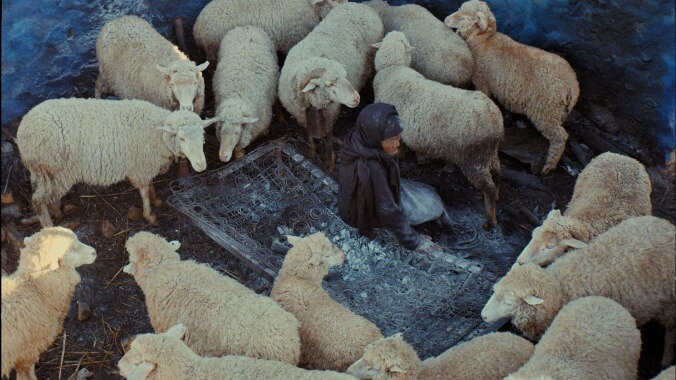Lesotho makes a haunting, hypnotic Oscars debut with This Is Not A Burial, It’s A Resurrection
Film Reviews Lesotho

This Is Not A Burial, It’s A Resurrection opens with the hypnotic force of an incantation. From a stutter-step blur of violent activity, we move to a hushed, dimly lit tavern where the camera performs an unhurried circular movement. The frame eventually settles on an unnamed narrator (Jerry Mofokeng Wa Makhetha), who relates the story of Mantoa (Mary Twala Mhlongo), an 80-year-old widow who learns that her son, her last living relative, has died in a mining accident. Thereafter, the name of the Lesotho region she calls home, the “plains of weeping,” resounds with bitter irony, and she enters a period of mourning from which she seems unlikely to emerge. But when she later learns that her village is to be resettled in order to make room for a dam project, and the area’s gravesites will have to be either moved or flooded, she protests—and manages to rouse her fellow villagers to action. In an area condemned to destruction, her presence answers a question suggested by the film’s title: What does it take to raise a village from the dead?
The third feature from Lesotho-born, Berlin-based director Lemohang Jeremiah Mosese, This Is Not A Burial won a Special Jury Award for Visionary Filmmaking at last year’s Sundance Film Festival, and also has the distinction of being Lesotho’s first submission to the Oscars. But its accomplishment goes beyond mere awards-mongering, impressively departing from narrative expectations. Maintaining that opening link to oral storytelling traditions, Mosese frequently strips out dialogue in favor of Makhetha’s narration and a richly layered soundscape.
Likewise, though Mantoa’s resistance to the dam project constitutes a dramatic through-line, This Is Not A Burial can hardly be considered a rousing call to arms. After a scene where the villagers join in song at Mantoa’s prompting, a woman tells her that she doesn’t think this burst of newfound energy will last. The elderly widow seems to have no more desire to live than before, and even tries to bribe an undertaker to dig a grave for her—an act forbidden by local tradition that recalls the central dilemma of Abbas Kiarostami’s Palme d’Or winner Taste Of Cherry. Nonetheless, her actions, however wearied, eloquently express the film’s governing subject: the relationship between individual grief and collective response.
Given the significance of the dam project, This Is Not A Burial may recall Jia Zhangke’s Still Life (2006), a film centered around China’s Three Gorges Dam, and which similarly explores the notion of “progress” and its inevitable human (not to mention environmental) costs. Like Jia’s film, This Is Not A Burial is political, but not stridently so, devoting more time to depicting local traditions like a sheep-shearing contest than to detailing the bureaucracy driving the development project. Stylistically, however, Mosese’s film ranges far afield of Still Life. The film’s limpid exteriors and textured, Academy-ratio compositions may recall the work of Lisandro Alonso, while its wine-dark interiors and focus on a single community bear comparison to Pedro Costa’s Fontainhas films and his more recent Vitalina Varela. And its landscape shots and their foreground-background play share something with the aforementioned Kiarostami. (Others have mentioned the work of Souleymane Cissé and Djibril Diop Mambéty.)
These reference points are worth mentioning not because This Is Not A Burial is unoriginal, but in order to convey the film’s aesthetic range. Mosese’s use of distinct, at times clashing formal approaches is undoubtedly deliberate. And if the film can at times seem difficult to assimilate, this is because its conflicts are as much stylistic as they are narrative. The present-tense urgency of the village’s struggles brushes up against the narration’s sense of a past-tense cultural myth; likewise, the film’s languid, almost ritualistic tableaux sharply contrast with unexpected bursts of intense action. There are longueurs where Mosese’s approach shows its limits, as the film’s rhythms go from stately to stultifying. More often, though, Mosese manages to fuse his film’s stylistic tensions with Mantoa’s struggles of expression, her efforts to carry on in both word and deed. This Is Not A Burial’s final moments depict a stirring act of defiance and a startling shift in perspective: It may be the end of a life, but the story lives on.
1 Comment
This sounds pretty interesting.Side note, but I’m constantly amazed by the gulf between this site’s film commentary and music commentary.